Objectives
- Understand what trade is;
- Understand what development is, and its;
- Understand what aid for trade is and how it impacts on the global economy;
- Understand how trade and development impact upon each other.
Below are the specific items that should have been covered by the end of this presentation:
- Trade;
- Development;
- Theories of trade;
- Aid for trade;
- The interrelation of trade and development.
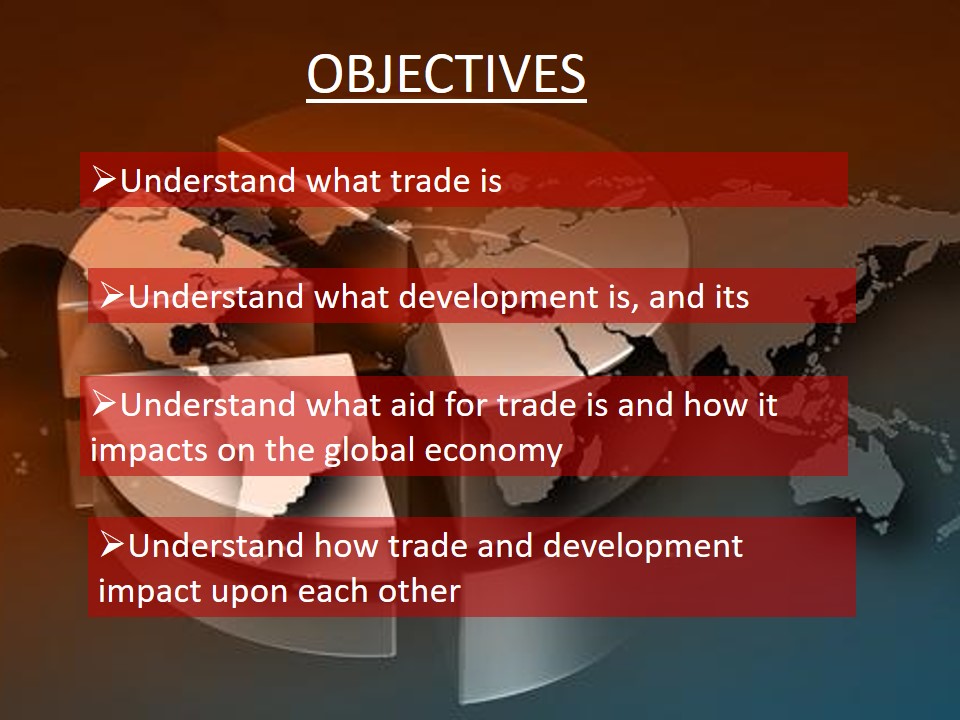
Trade
- Definition: The exchange of capital, goods and services across borders.
- Affects the economic, social and cultural aspects of society.
- Trade helps achieve a higher standard of living.
- Without trade, countries can only use what they produce.
Trade is the exchange capital, goods and services across borders or territories.
In most countries, such trade represents a significant share of gross domestic product(GDP).
While international trade has been present throughout much of history, its economic, social, and political importance has been on the rise in recent centuries (Abe and John, 2008).
Without international trade, nations would be limited to the goods and services produced within their own borders.
Simple economic analysis informs us that international trade is not an end unto itself, but a means to an end, a vehicle for achieving a higher standard of living through the more effective use of national resources.
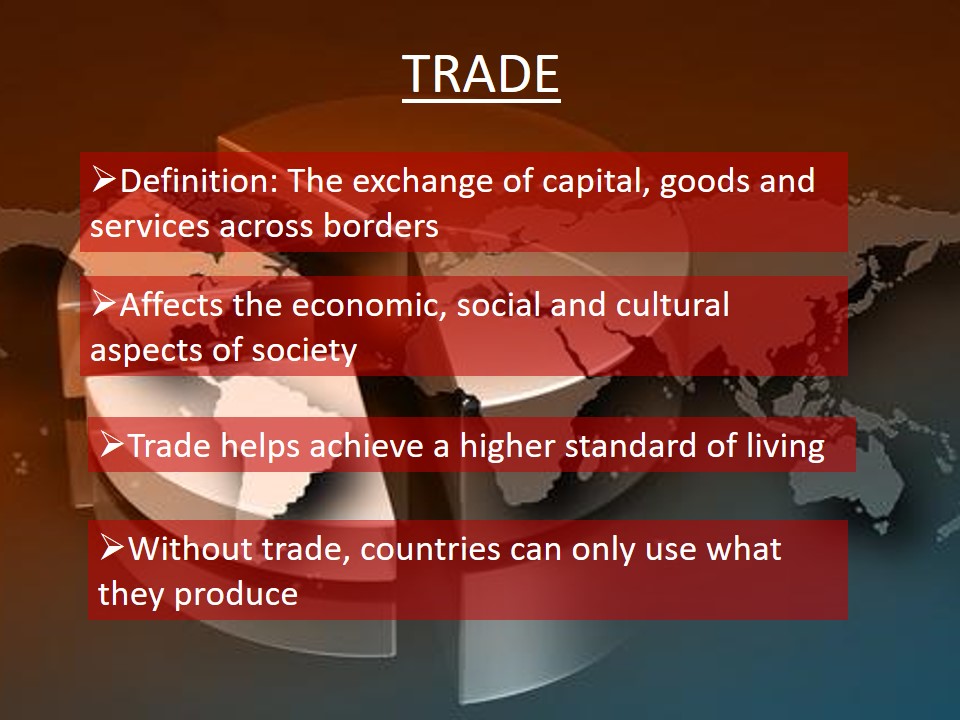
How Trade Works
- Developed countries sell equipment to developing countries.
- Developing countries sell raw materials to industrialized countries.
- Development in transportation and communication helps trade grow.
- Buyers and sellers are now more knowledgeably about markets and products.
Business firms in industrial countries sell machinery and equipment to developing countries, which, in turn, sell raw materials to firms in industrial countries (Kosack, 2008).
The growth of international trade has been greatly helped by modern techniques of transportation and communications.
These relatively new developments have brought countries closer together than they have ever been in the past and have made conduct of trade much easier.
More up-to-date and complete international economic information has made the buyer and seller more knowledgeable regarding available products and markets.
For the Less Developed Countries (LDCs) the advancements in transportation and communication have made the subjugated position under which many believe they have lived under for years glaringly obvious.
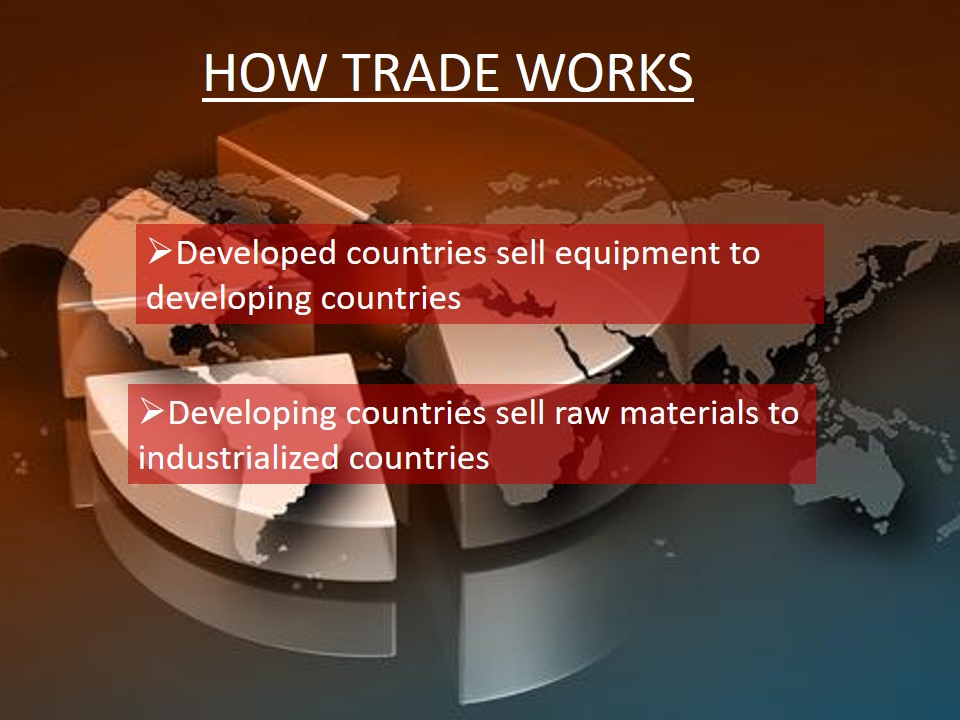
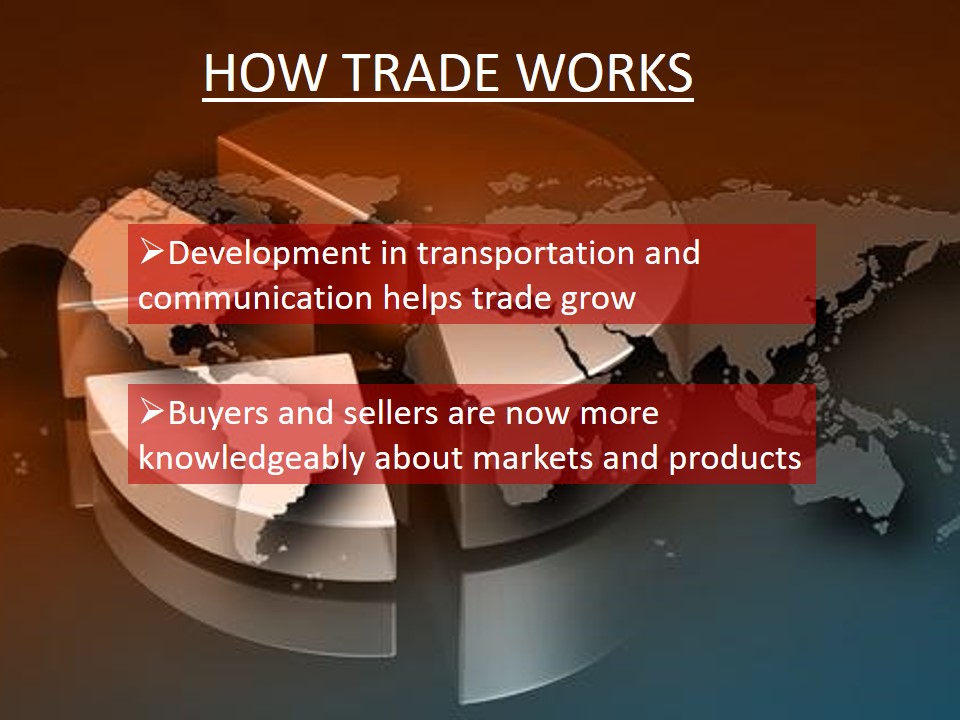
Development
- Definition: Changes in structure, institutions and attitude.
- A developing nation is one in which people are beginning to use available resources in order to increase the production of goods and services.
- Constant inflow of capital is needed to sustain the development process.
- Development is on top of the international community’s agenda.
- Power is no longer linked to military strength but to economic wealth.
- Countries are not building armies, but are instead obtaining wealth, with an aim of becoming superpowers.
Development refers to structural changes, changes in institutions, and changes in attitude.
Developing is a state of existence, development is the process of improving that state of existence.
Infusions of capital are needed regularly to continue the development process. Capital comes from many sources, including foreign and domestic investment. In recent years, large amounts have come in the form of loans.
A nation whose people are beginning to utilize available resources in order to bring about a sustained increase in per capita production of goods and services is a developing nation.
The issue of development is currently one of the most pressing issues facing the international community.
Whereas power in the past has been defined as military might, the current standard is rapidly becoming economic wealth (Arvin and Choudry 2000).
Nations are struggling not to build armies, but to obtain wealth and the resources that go with it.
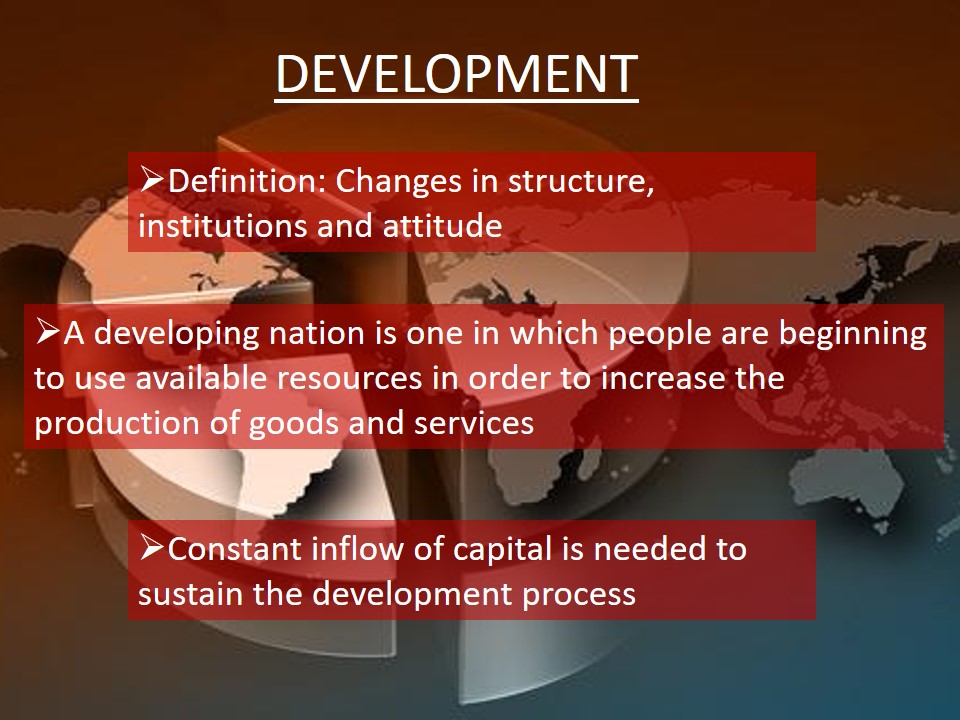

How Trade Impacts on Develpment
- Trade and development are linked positively and negatively.
- Good use of trade can contribute to a country’s development.
- However, opening up markets to international trade can leave local goods without a market.
The relationship between a country’s trade and its economic development has always been a subject of interest.
The current consensus is that trade, development, and poverty reduction are intimately linked in both positive and negative ways.
Successful use of trade can greatly contribute to a country’s development (Haddad, Jamus and Christian, 2010).
Export has been a key part of many countries’ successful development strategies (Kosack, 2008).
On the other hand, opening up markets to international trade may leave local producers swamped by more competitive foreign producers.
Countries that develop can be easily be seen to have strong trade relations with other countries across the world.
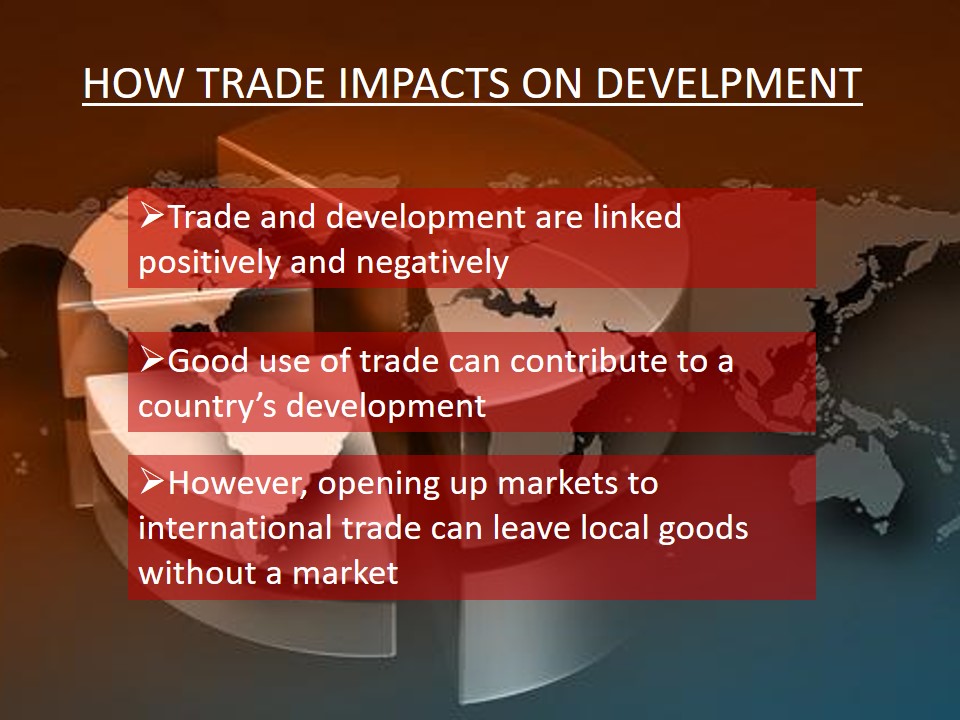
Theories Explaining Trade and Development
- Classical theory: Free trade will lead to efficient use of a country’s resources:
- Openness to trade improves economic performance by increasing competition.
- Comparative advantage:
- Developing countries should protect their manufacturing industries.
- New trade theory:
- Specialization increases output.
Economic theory can provide a framework for analyzing the relationship between trade and development, such as sorting out the various mechanisms by which one can affect the other, but theory does not offer guidance that is decisive when it comes to policy.
The classical view, often associated with Adam Smith, is that free trade will lead to the most efficient use of a country’s resources and therefore yield the highest national income (Haddad, Jamus and Christian, 2010).
Openness to trade improves economic performance by increasing competition and by giving domestic firms access to the best foreign technology, which can be adopted to raise domestic productivity.
An alternative view, associated with the nineteenth century political economist David Ricardo, suggests that developing countries should protect their infant manufacturing industries from foreign competition to foster their growth and allow them to catch up to industrial leaders.
This view suggests that government assistance to shift resources out of primary products and into manufacturing would promote economic development and prevent prolonged specialization in low value-added activities.
In industries with high fixed costs specialization increases output which in turn increases the ability to enhance economies of scale.

Institutions Governing Trade
- GATT:
- Signed in 1946;
- Outcome of failure to form International Trade Organization;
- Replaced in 1993.
- WTO:
- Deals with rules of trade;
- Ensures trade flows ass smoothly and freely as possible.
- OPEC:
- Develops ways of stabilizing prices in international oil markets;
- Helps maximize trade and development opportunities for developing countries.
The General Agreement on Tariffs and Trade (typically abbreviated GATT) was negotiated during the UN Conference on Trade and Employment and was the outcome of the failure of negotiating governments to create the International Trade Organization (ITO).
GATT was signed in 1946 and lasted until 1993, when it was replaced by the World Trade Organization in 1995. The original GATT text (GATT 1946) is still in effect under the WTO framework, subject to the modifications of GATT 1994.
The World Trade Organization (WTO) deals with the global rules of trade between nations. Its main function is to ensure that trade flows as smoothly, predictably and freely as possible.
Organization of Petroleum Exporting Countries) is an intergovernmental organization of 12 oil-producing countries . It also pursues ways and means of ensuring the stabilization of prices in international oil markets with a view to eliminating harmful and unnecessary fluctuations.
Seeks to maximize the trade, investment and development opportunities of developing countries while helping them face the challenges of globalization
GATT and UNCTAD are the two major organizations where developed and developing nations gather to discuss trade issues.

Issues Affecting Trade
- Market Access:
- Access to markets in developed countries can help reduce poverty
- New trading opportunities help open up new markets
- Barriers to trade-Tariffs:
- High tariffs imposed on agricultural goods discourage diversification.
- Complex tariffs make it difficult for developing countries to access industrialized countries
- Lack of capacity:
- Non-tariff barriers e.g. food regulations and standards
- Proper infrastructure
- Customs documentation
Market access
The issue of market access to high-income countries has a serious impact on trade.
Many of the world’s poor live in developing countries, and so market access alone can have significant poverty-reducing effects in these countries.
However, for the least-developed countries, the principal problem is not market access, but lack of production capacity to achieve new trading opportunities (Cali and Willem, 2008).
Barriers to trade
High tariffs are imposed on agriculture: in high-income countries, the average tariff rate on agriculture is almost double the tariff for manufactures. And more than one third of the European Union’s agricultural tariff lines, for instance, carry duties above 15%
Strong tariff escalation is typically imposed on agricultural and food products by high-income countries. This strongly discourages the development of high value added exports, and hinders diversification in particular as well as development in general (UN Millennium Taskforce on Trade, 2005).
Complex tariffs make it more difficult for developing country exporters to access industrialized-country markets because of the disadvantages developing countries face in accessing, and in their capacity to process, information. Not only are price signals distorted, they are often unclear, subject to change (for example seasonally) and difficult to interpret.
Lack of capacity
This includes non-tariff barriers such as food regulations and standards, which developing countries are often not involved in setting, and which may be deliberately used to reduce competition from developing countries (Cali and Willem, 2008).
Trade agreements must generate relevant reforms in areas such as customs documentation, but also more fundamentally in relaxing rules for cross-border transportation.
Poor or wrong infrastructure can restrict trade.
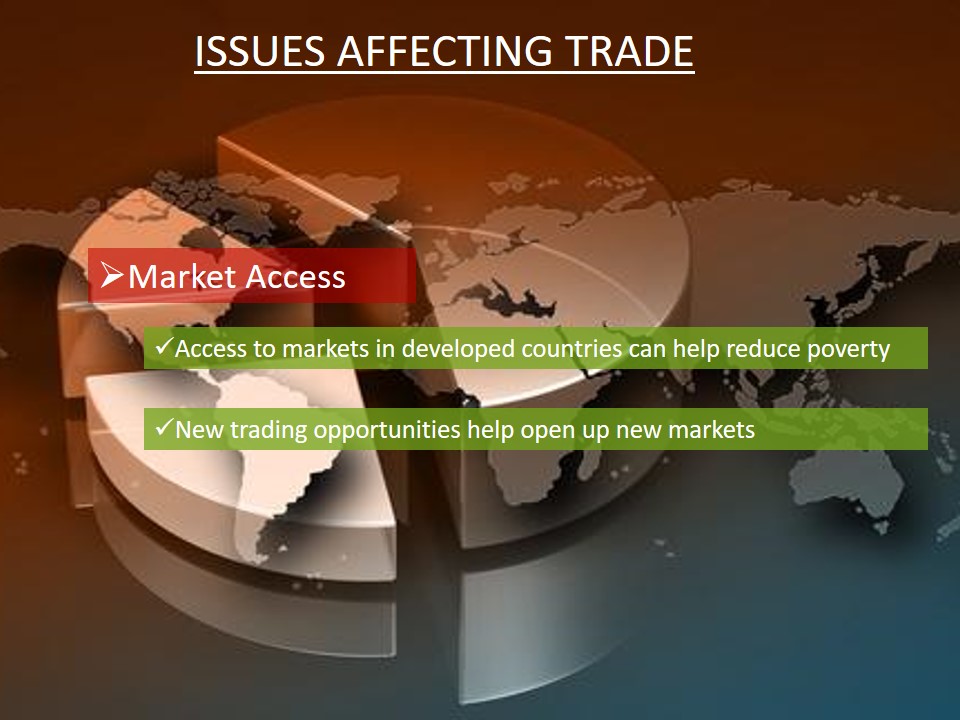
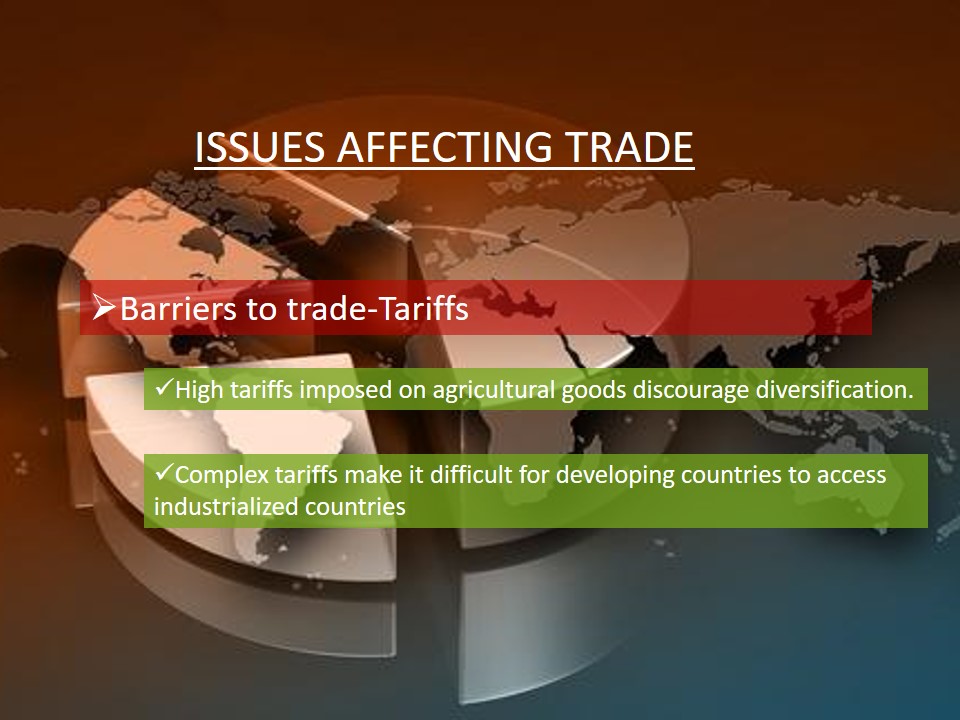
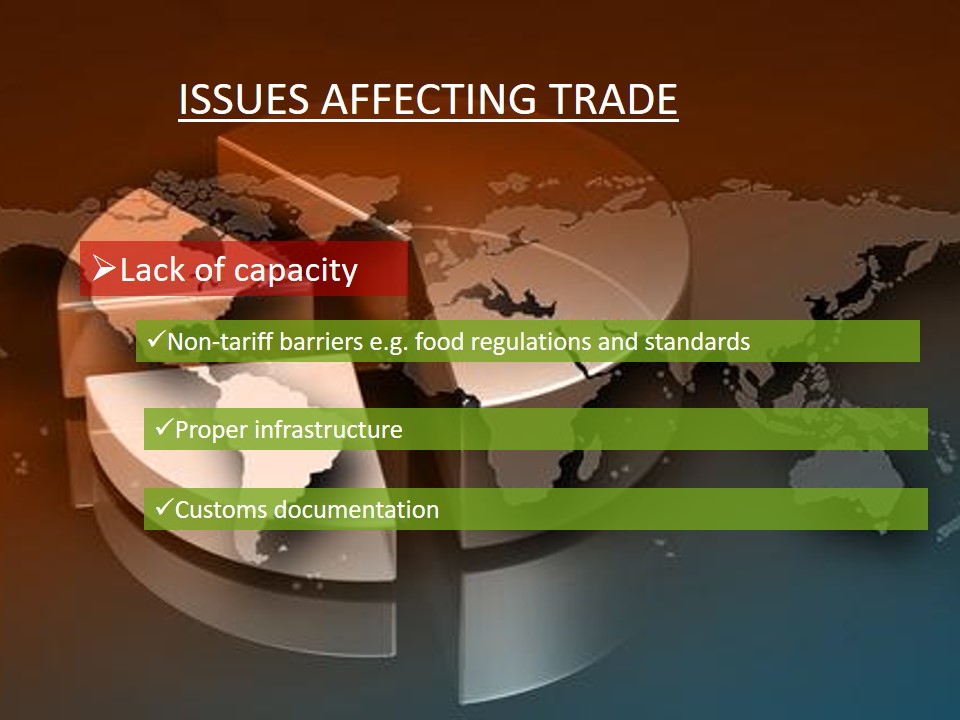
Issues That Slow Down Trade
- High costs.
- Fear of cultural contamination.
- Market forces- An impact in the market might ruin an entire economy.
- Overdependence-Dependence on the west can be demoralizing.
The cost of international trade can be high, and nations may be forces to divert scarce resources from other areas to develop a successful export economy.
Trade many result in a divided economy, made up of a small market-based economy and a large subsistence economy that is starved of resources (UNCTAD, 2005).
Likewise, many nations are reluctant to trade due to the fear of cultural contamination.
In many cases, the on-set of an industrial economy brings with it new problems such as changes in population growth, migration and social changes. Some people fear what might happen when trade is stimulated, and are unwilling to trade their impoverished conditions for an uncertain future.
Market forces: Often times a country will specialize in one or two industries, and if something in the market should upset their exports, economic ruin may come to the entire country.
One fear expressed by many in the Third World deals with the problem of dependence.
Once development gets underway, many countries become dependent, especially upon the West, for materials and expertise. This can be demoralizing for a nation, especially one with a long history of colonialism. For some countries, development is a debate between domination and independence (Reis and Thomas, 2010).
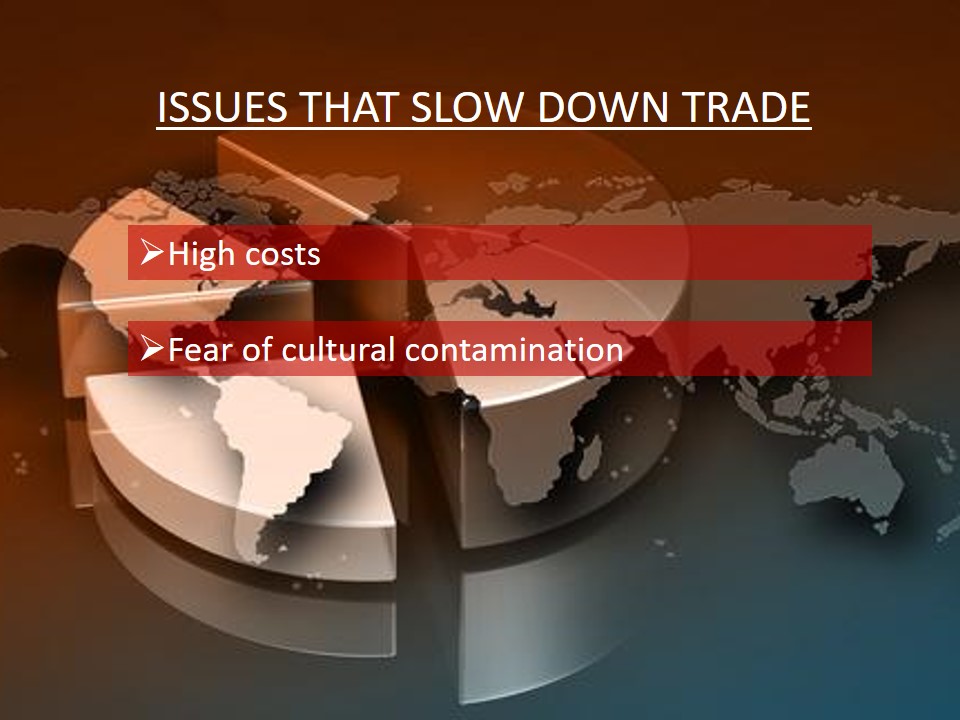
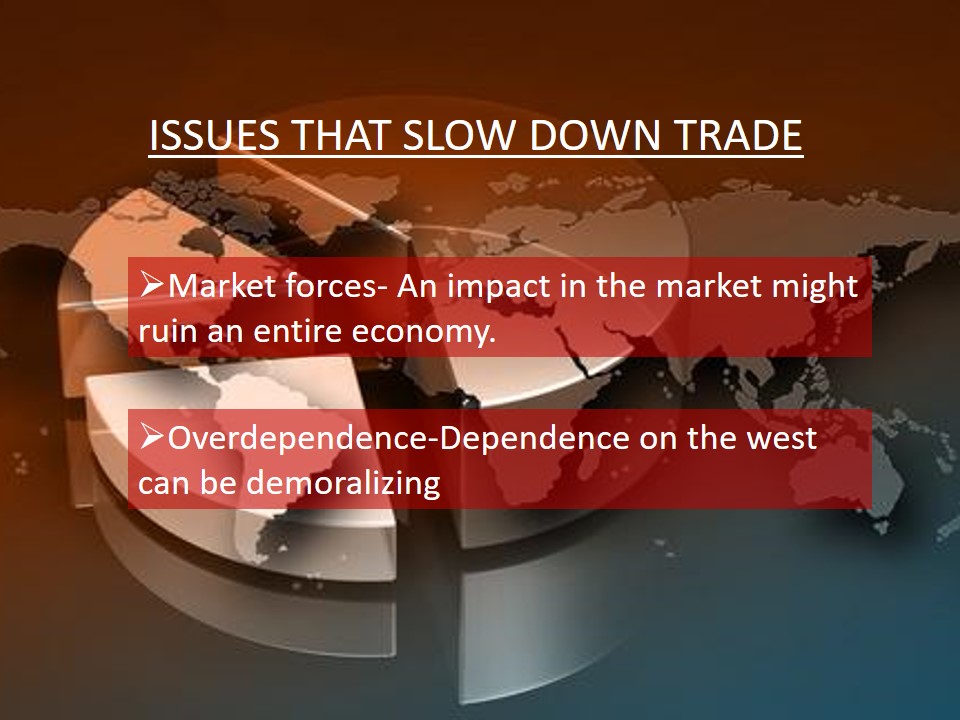
Interdependence and Its Impact on Trade Development
- Decisions in one country affects other nations.
- In the past, foreign aid as used to solve issues of developing countries.
- Nowadays, trade has come in to help developing countries deal with their issues.
Decisions made in one nation have always had, at the very least, the potential to impact many other nations.
In today’s world, where decisions made in one country will reach other countries in minutes instead of months as in earlier times, the interdependence of nations is simply more visible (Djankov and Pham, 2006).
It is only recently that trade has been linked to the development of the Third World.
In an inter-dependent world, Third World problems become First World problems quickly (Francous and Hoekman, 2009).
As nations sink further into poverty, their citizens migrate to where there are jobs and a higher standard of living.
In the past, development was seen as a problem to be solved by foreign aid and loans from developed countries in the East and West.
However, aid has never come without strings attached, and many countries saw foreign aid as an attack on their sovereignty.
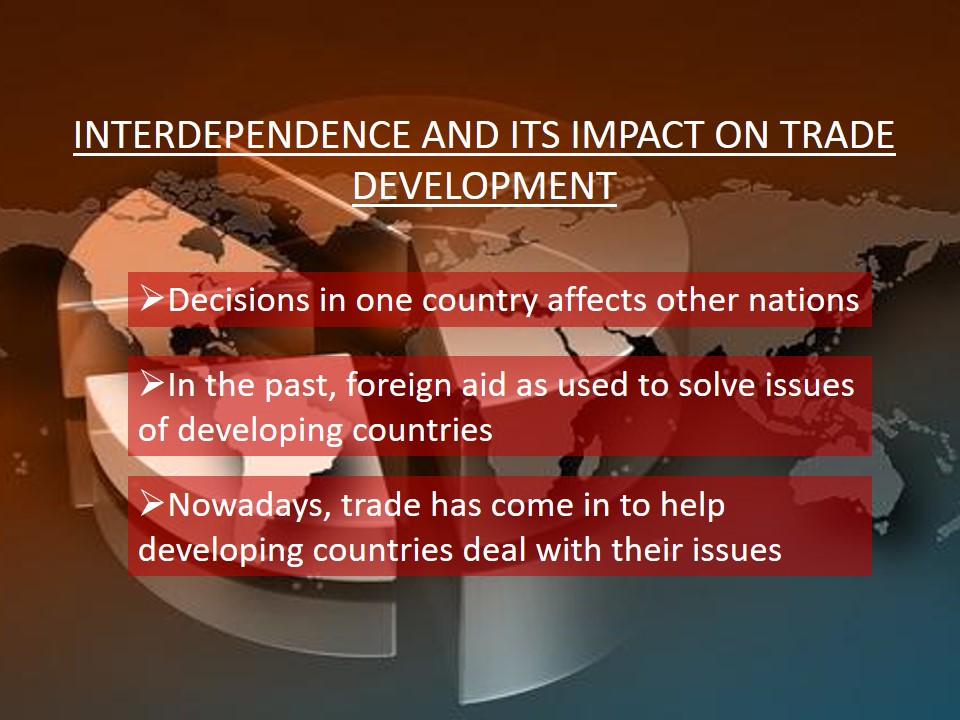
Aid for Trade
- Financial and technical assistance to facilitate the integration of developing countries into the global economy.
- Example: Financing of transportation.
- Also incldes measure to assist workers, producers and communities.
Aid for trade is financial and technical assistance that facilitates the integration of developing countries into the global economy through initiatives that expand trade. By furthering economic growth and development, the benefits of aid for trade are shared by all trading nations.
This includes not only the poor in least developed and other low-income countries, but also citizens in middle income countries and those in the most developed nations of the globe. Trade benefits all nations (Portugal-Perez and John, 2009).
Examples of aid for trade include the financing of transportation and logistics infrastructure (infrastructure is the largest share of official development assistance in aid for trade), assistance to help firms conform to international product standards, capacity building in border management, and implementation of projects that connect rural producers to markets.
Aid for trade also spans measures to assist workers, producers and communities in adjusting to changes in trade policies or the terms of trade (e.g., as a result of erosion of trade preference programs).
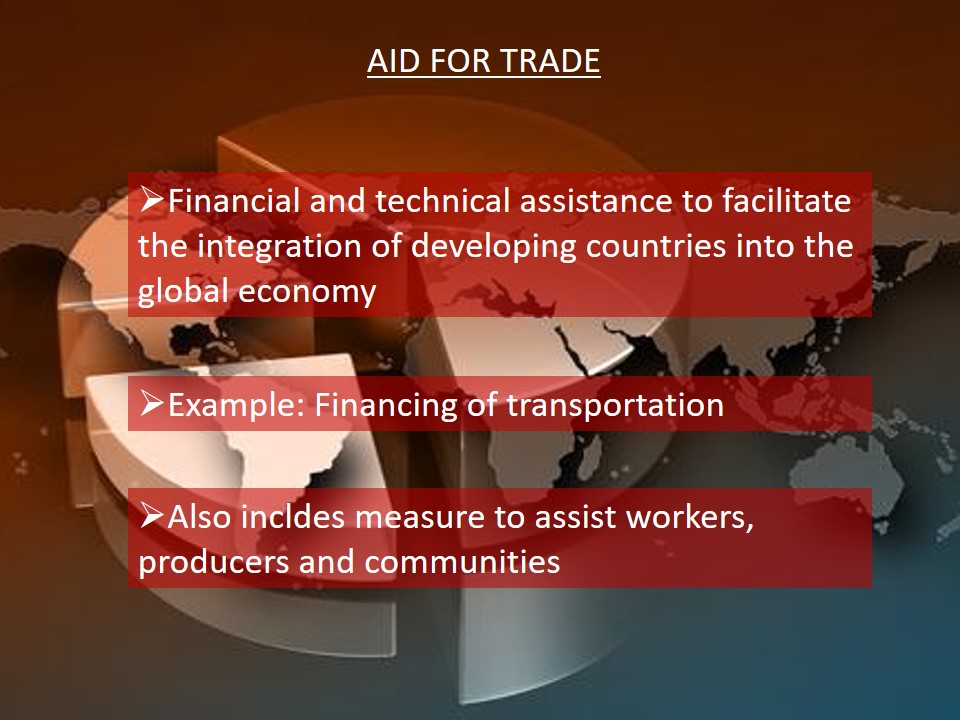
Benefits of Aid for Trade
- Can help increase diversification:
- Diversification helps reduce volatility of output.
- Enhances productivity:
- Helps deal with negative competitiveness, coming from too much aid going into a country.
- Reduces protectionism:
- Helps increase support for trade reforms, hence keeping them open to global trade.
Aid for trade can help increase diversification. Trade openness gives rise to risks as well as benefits.
Diversification can help reduce output volatility. Many low-income countries are not well diversified – in part because of high trade and other costs that aid for trade can help reduce (Haddad, Jamus and Christian, 2010).
Aid for trade can enhance productivity in low-income countries. There is a long-standing debate regarding developing countries’ capacity to effectively absorb increased flows of aid. This can act to offset negative competitiveness spillovers generated by aid inflows.
It can also help reduce pressures for protectionism and increase support for trade reforms in developing countries, further expanding trade prospects by helping to keep markets open globally
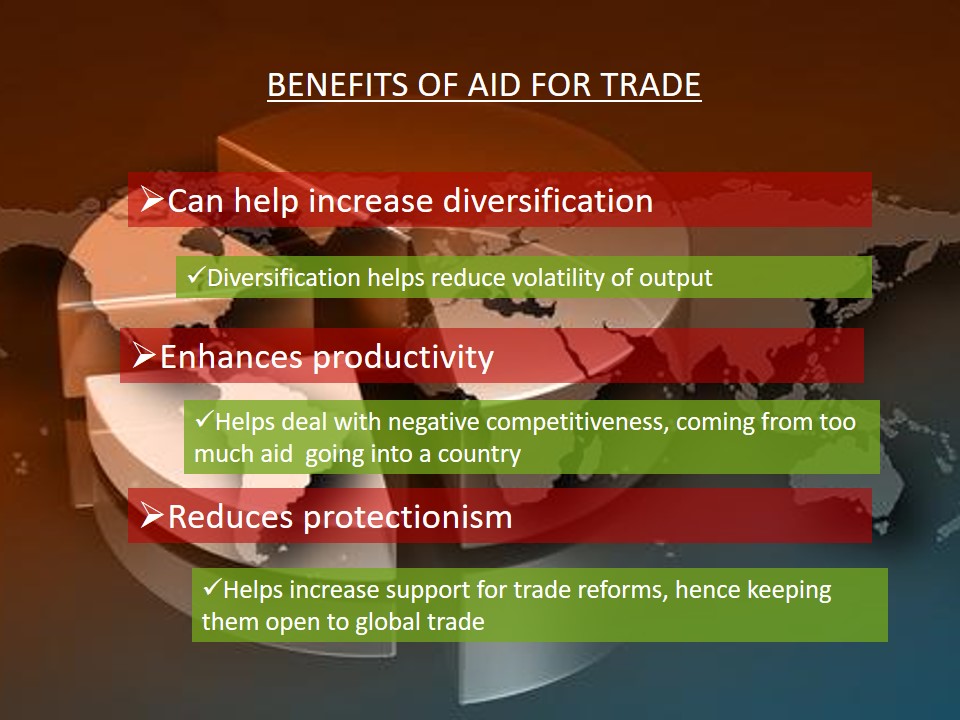
How Expansion of Trade Will Benefit Developing Countries
- It will help countries overcome the shock of crisis.
- Will help in diversification of products and markets.
- Can improve productivity through lowering costs.
Given the lack of progress in bringing the WTO agreement to bed, the developed countries should provide an important signal that the major players in the world economy recognize the importance of taking actions to expand trade (Kosack, 2008).
Trade is a powerful mechanism to help countries overcome the shock of the crisis.
Aid for trade can help countries diversify into new markets and products—helping poor countries benefit from the emergence of a multi-growth pole world economy.
Aid for trade, allocated effectively, can improve productivity in recipient countries by lowering costs and enhancing competitiveness, thereby enhancing growth prospects.
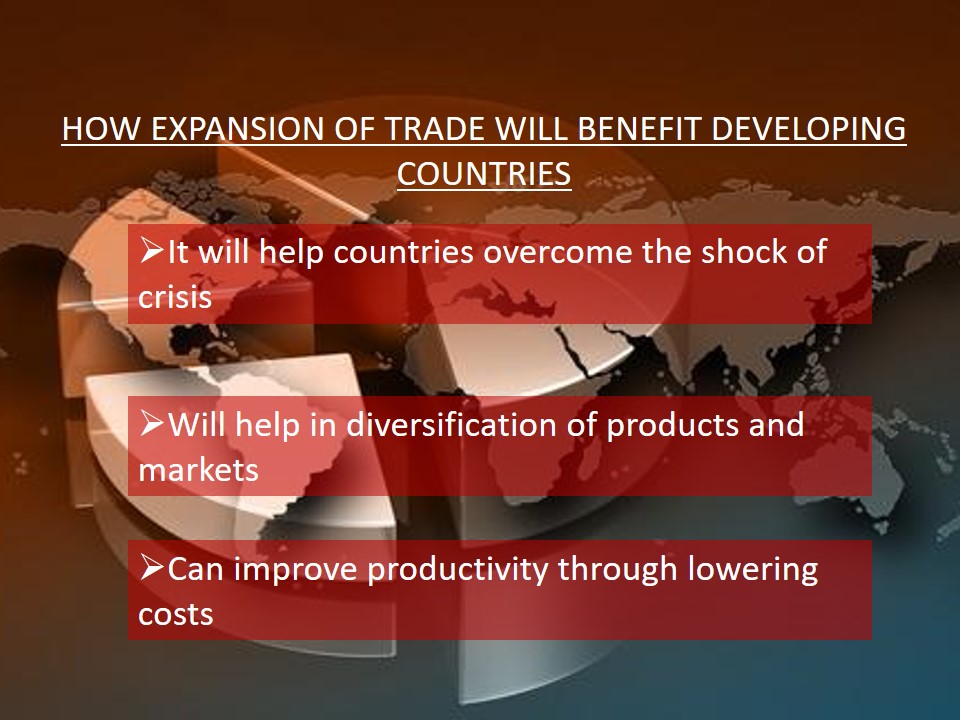
Summary
- Trade is the engine of development.
- It allows nations to develop labor skills.
- As industries develop, they generate wealth for citizens and government.
- Trade brings in money to an economy and workers spend it in the same economy, hence development.
- Trade allows countries to obtains things they would not have had.
- Most countries use exports to finance production.
Out of the failure of foreign aid and loan policies, nations have come to view trade as “the engine of development.”
Trade has a number of advantages when compared with foreign aid and loans.
For one thing, it allows a nation to develop certain labor skills, skills that can often be transferred from international companies to domestic industries.
As nations develop their own industries, they in turn generate wealth for both citizens and the government.
Trade also has a trickle-down effect within a developing economy, as workers spend their money, spurring on further development.
Perhaps even more important, trade allows a country to obtain those things it could not otherwise produce.
Many countries depend upon using exports to finance the cost of raising production and incomes.

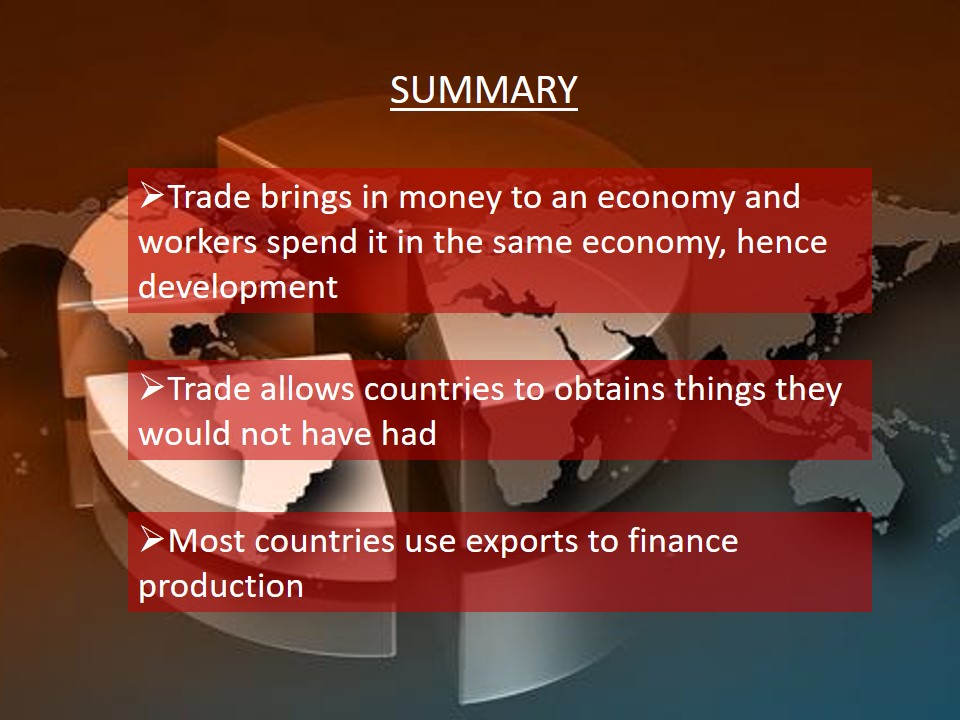
Reference List
Abe, K and John, S 2008, “Trade, Transparency, and Welfare in the Asia Pacific,” Journal of International Economic Studies 12(2): 35-78.
Arvin, C and Choudry, S, 2000, “A causality analysis of untied foreign assistance and export performance: the case of Germany,” Applied Economic Letters, 7:315-319.
Cali, M and Dirk Willem, V 2008, “Towards a Quantitative Assessment of Aid for Trade,” London: Commonwealth Secretariat.
Djankov, F and Pham, C 2006, “Trading on time”, Policy Research Working Paper 3909, The World Bank.
Francois, J and Hoekman, B 2009. “Services Trade and Policy,” Journal of Economic Literature, forthcoming.
Haddad, M, Jamus, L and Christian, S 2010, “Trade Openness Reduces Growth Volatility When Countries are Diversified,” World Bank Policy Research, Working Paper 5222.
Kosack, S 2008, “Trade for Poverty Reduction: The Role of Trade Policy in Poverty Reduction Strategy Papers,” United Nations Development Program, New York.
Portugal-Perez, A and John, W 2009, “Why Trade Facilitation Matters to Africa,” World Trade Review 8:3 379-416.
Reis, G and Thomas, F 2010, “Exports and the competitiveness agenda: policies to support the private sector,” in O. Canuto and M. Giugale (eds.) The Day After Tomorrow: economic policy challenges for developing countries in the post-crisis world, World Bank, forthcoming.
UNCTAD, 2005, Trade and Development Report, 2005. United Nations publication. New York and Geneva.
UN Millennium Taskforce on Trade, 2005, Trade for Development. New York: UN Millennium Project.